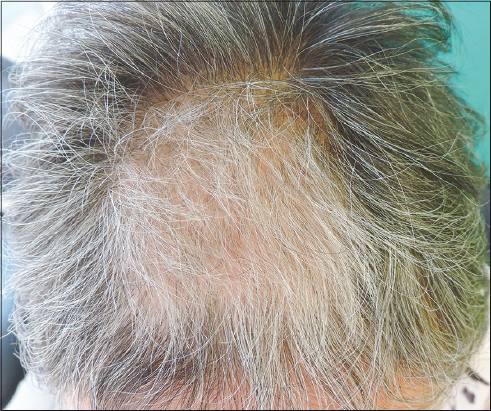Rectangular alopecic patch: A possible suspicion
Francisco Javier De la Torre Gomar, Javier Gimeno Castillo , Amaia Saenz Aguirre
, Amaia Saenz Aguirre
Department of Dermatology, University Hospital Hassan II, Fes, Morocco
Corresponding author: Javier Gimeno Castillo, MD
Submission: 02.12.2020; Acceptance: 14.02.2021
DOI: 10.7241/ourd.20212.26
Cite this article: De la Torre Gomar FJ, Gimeno Castillo J, Saenz Aguirre A. Rectangular alopecic patch: A possible suspicion. Our Dermatol Online. 2021;12(2):198-199.
Citation tools:
Copyright information
© Our Dermatology Online 2021. No commercial re-use. See rights and permissions. Published by Our Dermatology Online.
65-year-old female was referred to the dermatology department because of an alopecic patch located on the frontal-parietal region of the scalp, gradually progressing over the previous month. The patient had undergone fluoroscopically guided endovascular embolization of an anterior communicating artery aneurysm fifteen days before its development. The patient did not have a family or personal history of alopecia. She denied having a history of drug use, suspicious hair care practices, and pruritus or other symptoms.
A physical examination revealed a sharply-delineated, rectangular, alopecic area located on the referred region of the scalp, 14 × 10 cm in size (Fig. 1). The alopecic patch was skin-colored. No erythema, scarring, or scaling was found on clinical and dermoscopy examination. No exclamation mark hairs were evident on dermoscopy and the hair pull test was negative. Thus, the diagnosis of radiation-induced transient alopecia (RITA) was reached.
 |
Figure 1: Rectangular, sharply-demarcated, alopecic area located on the central frontoparietal area of the scalp with a tendency toward hair regrowth visible. |
Hair growth returned six months after the endovascular procedure and no other interventions were necessary (Fig. 2).
 |
Figure 2: Six months after the endovascular procedure. |
RITA is explained by the high sensitivity of anagenic hair follicles to radiation. RITA is becoming more frequent due to the increasing use of endovascular interventional procedures in the last twenty years [1]. It is characterized by a non-scarring geometrical, mostly rectangular, alopecic patch restricted to the area of radiation [2]. RITA is usually asymptomatic and without signs of scalp inflammation [2]. Alopecia usually begins two to five weeks after the endovascular procedure [1].
The diagnosis of RITA is based on a typical clinical presentation and a history of exposure to radiation.
Because of its benign and transient nature, RITA requires no particular treatment. Complete hair regrowth generally occurs within two to six months after irradiation [1]. Due to its self-limiting nature, the main therapeutic goal is to recognize this entity in order to avoid unnecessary interventions as well as to reassure the patient,
Consent
The examination of the patient was conducted according to the principles of the Declaration of Helsinki.
The authors certify that they have obtained all appropriate patient consent forms, in which the patients gave their consent for images and other clinical information to be included in the journal. The patients understand that their names and initials will not be published and due effort will be made to conceal their identity, but that anonymity cannot be guaranteed.
REFERENCES
1. Yu SR, Zhang JZ, Pu XM, Kang XJ. Bowen’s disease on the palm:A case report. World J Clin Cases. 2019;7:2910-5.
Notes
Source of Support: Nil,
Conflict of Interest: None declared.
Request permissions
If you wish to reuse any or all of this article please use the e-mail (brzezoo77@yahoo.com) to contact with publisher.
| Related Articles | Search Authors in |
|
 http://orcid.org/0000-0002-3307-9005 http://orcid.org/0000-0002-3307-9005 http://orcid.org/0000-0001-5678-8288 http://orcid.org/0000-0001-5678-8288 http://orcid.org/0000-0002-4400-7859 http://orcid.org/0000-0002-4400-7859 |



Comments are closed.